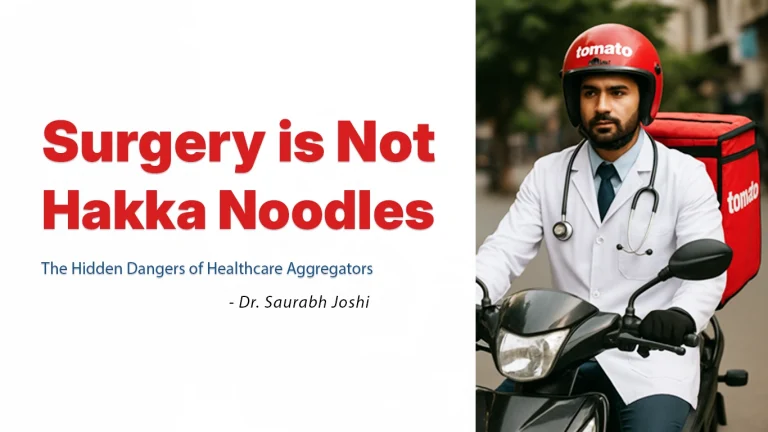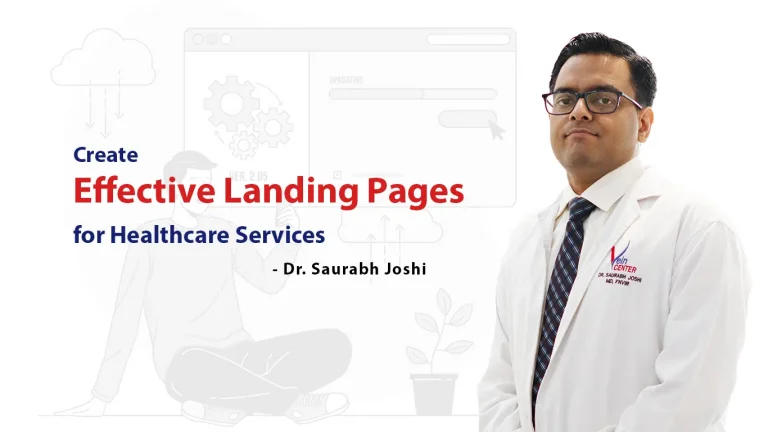Call Us Now

Dr. Saurabh Joshi’s Review of Current Leading Assisted Cashless NBFCs in India
The assisted cashless method, a blend of healthcare financing and insurance, revolutionized patient care in India about five years ago. Initially, it offered straightforward financing options with fixed repayment schedules. However, it quickly evolved to incorporate insurance policy-linked procedure value loans featuring EMIs (Equated Monthly Instalments) with moratorium periods aligning with the typical claim settlement durations. Over time, these services expanded to include comprehensive document processing, diligent answering of queries, and patient handholding throughout the claim process, enhancing the overall patient experience.
Ideal Characteristics of Assisted Cashless Companies
In an ideal setting, an Assisted Cashless Company should exhibit several core competencies:
Prompt Disbursement:
The company should disburse the entire amount needed for surgery upfront, ensuring that medical procedures are not delayed due to financial constraints.
Efficient Paperwork Handling:
Quick processing of necessary documentation to avoid bureaucratic delays that can add to the patient’s stress.
Proactive Insurance Liaison:
Active follow-ups with insurance companies to resolve queries and secure reimbursements swiftly.
EMI Moratorium Advantage:
Enabling patients to repay the loan within the moratorium period, ideally without having incurred any EMIs, which aligns financial repayment with insurance claim settlements.
Stress-Free Experience for All Parties:
Minimizing the mental and emotional stress involved in medical treatments for patients, healthcare providers, and caretakers.
Reality Check: Does the Ideal Match the Actual?
Despite the promising framework, the reality of the assisted cashless experience can vary. Based on our direct interactions and operational integration with several NBFCs offering these services, we’ve had a mix of positive and challenging experiences.
Review of Four Leading Assisted Cashless NBFCs
Today, we review four such companies with whom we’ve personally worked. This analysis will delve into the nuances of each service provider, noting where they excel and where they fall short, providing a candid look into the practicalities of partnering with these financial entities.
NBFC A:
Known for its quick disbursement, this company sets a high standard in timely financial handling but sometimes lacks in efficient paperwork processing, causing occasional delays.
NBFC B:
Offers excellent customer service with dedicated personnel for query handling and patient support, though their follow-up with insurance companies often requires nudging.
NBFC C:
Stands out for its seamless paperwork and insurance liaison efforts but falls short in the flexibility of repayment terms, which can cause financial strain on patients.
NBFC D:
Demonstrates robust overall performance with quick disbursement and efficient claim handling but occasionally struggles with the EMI moratorium schedule, leading to discrepancies in patient billing.
Detailed Reviews
Review of Company A:
Pure Financing with a Focus on Hospital Guarantees
Operational Model:
Company A offers a pure financing model, where the primary responsibility for managing paperwork and processing insurance claims rests with the hospital. This approach places significant administrative duties on the hospital, requiring a dedicated team to handle insurance interactions and ensure compliance with financial agreements.
Strengths:
- Quick Disbursement: Company A is efficient in disbursing funds, which helps in initiating treatments without delay, benefiting patients who require immediate medical attention.
- Simplified Patient Interaction: Patients are not burdened with the complexities of paperwork or insurance liaising, which can be reassuring and reduce stress during medical treatments.
Challenges:
- Hospital as Guarantor: The stipulation that the hospital acts as guarantor introduces significant financial risk. If a patient defaults, the hospital is financially liable, which can impact its financial stability.
- High Administrative Burden: Hospitals need to allocate resources to chase down payments from insurance companies, ensuring that claims are settled in full and in a timely manner. This can strain hospital resources, diverting attention from medical to administrative tasks.
- Recovery Practices: In instances where a patient disappears post-treatment, Company A’s practice of depositing the hospital’s guarantee cheque instead of pursuing the patient can lead to serious financial implications for the hospital. This approach may strain the hospital’s relationship with the financing company and could impact its willingness to continue such arrangements.
Operational Risks:
- Patient Default: The biggest risk arises when a patient defaults and disappears post-treatment. Despite the hospital’s efforts, if the insurance claim is not settled or if there’s a shortfall, the financial burden falls on the hospital.
- Financial Stability: Continuous exposure to financial risks of this nature could affect the hospital’s overall financial stability and reputation.
Review of Company B:
Combining Financing with Claim Processing
Operational Model:
Company B’s model integrates financing with claim processing, aiming to streamline both financial disbursement and the necessary documentation handling. This approach is designed to simplify the administrative load on hospitals and enhance the patient care experience by ensuring financial and procedural matters are handled efficiently.
Initial Experience:
- Prompt Services: Initially, Company B exhibited exemplary service with on-time fund disbursements and efficient document collection. The first month set a positive tone, with operations running smoothly and expectations being met or exceeded.
Emerging Challenges:
- Delayed Disbursals: After the first month, the efficiency of fund disbursements declined. Delays became more frequent, affecting the hospital’s ability to manage cash flows and patient treatments timely.
- Bulk Disbursals without Clarity: Company B started processing payments for multiple patients in bulk without providing detailed statements to clarify the allocation of funds per patient. This lack of transparency complicated financial reconciliation and accounting processes for the hospital.
- Accounting Errors: Instances of underpayment were noted, with Company B occasionally disbursing funds for one less surgery than required and subsequently acknowledging the oversight as a mere forgetfulness. Such errors further strained the operational efficiency.
- Document Handling Issues: There were significant lapses in document management, including not picking up documents on time. More critically, there were instances of original documents being misplaced, with the company then requesting the hospital to issue new original bills—an often impractical and risky request.
Operational Risks:
- Financial Reconciliation: The lack of detailed disbursement statements and occasional financial miscounts could lead to significant accounting challenges, potentially resulting in financial losses or discrepancies for the hospital.
- Document Security: The mismanagement and loss of original documents not only disrupt the claims process but also pose security and compliance risks, potentially leading to breaches of patient confidentiality and trust.
- Operational Inefficiency: Delays and errors in financial and document management disrupt the hospital’s operations, potentially affecting patient care and trust in the hospital’s administrative capabilities.
Review of Company C:
Efficient Payments with Persistent Paperwork Challenges
Operational Model:
Company C provides a combined service of financing and claim processing similar to other assisted cashless companies, but with a more reliable track record in terms of payment accuracy. This company aims to offer a streamlined financial process without the common errors seen in some competitors.
Strengths:
- Accurate Disbursals: Company C stands out for its reliability in financial dealings. Unlike others, it maintains consistency in disbursing the correct amounts without errors, which significantly aids in maintaining hospital operations without financial hiccups.
- Timely Payments: Payments are generally timely, ensuring that the hospital can proceed with treatments without delays caused by financial constraints.
Challenges:
- Paperwork Processing Delays: Despite the financial accuracy, Company C struggles with efficient paperwork processing. There are indications that the company may not prioritize rapid processing of claims, possibly delaying activities until the commencement of the EMI period.
- Perceived Lack of Urgency in Claim Settlement: The approach taken by Company C suggests a strategy of deferring claim settlements. This can be interpreted as a tactic to extend the period before engaging with insurance companies, possibly to minimize their own operational burden until it becomes financially necessary to act.
Operational Risks:
- Delayed Claim Settlements: The slow pace in handling paperwork could lead to delays in insurance claim settlements, which can adversely affect the hospital’s financial cycle and patient satisfaction.
- Financial Impact on Patients: If claim settlements are delayed beyond the start of the EMI period, patients may end up paying out of pocket, which could lead to dissatisfaction and potential financial distress for patients who were not prepared for immediate outlays.
Review of Company D:
Leading the Pack with Minimal Follow-Up Needed
Operational Model:
Company D operates on a similar model to other assisted cashless companies, offering financing combined with insurance claim processing. It aims to streamline both financial and administrative processes for hospitals and patients.
Strengths:
- High Operational Efficiency: Company D has shown itself to be the most effective among the companies reviewed. They generally handle disbursements and paperwork with higher efficiency and fewer errors, which is essential for smooth hospital operations and patient satisfaction.
- Reliable Payments: Payments from Company D are consistent and timely, allowing for uninterrupted patient care without the financial delays often encountered with other companies.
Areas for Improvement:
- Need for Follow-Up: Despite its superior service, there remains a need for occasional follow-up by the hospital staff. This is primarily to ensure that all processes are completed as expected and within reasonable timeframes.
Operational Risks:
- Dependency on Follow-Ups: While minimal, the requirement for follow-ups indicates that the systems are not entirely foolproof. There is a risk that without diligent oversight, some processes might not be completed as efficiently or effectively as they could be.
Selecting Your Assisted Cashless Provider: Key Considerations
Navigating the landscape of assisted cashless providers can be complex, but focusing on the right factors can ensure you choose a partner that aligns with your hospital’s operational needs and financial ethics. Here are crucial points to consider:
- Avoid Guarantor Clauses: Do not sign any agreement that makes your hospital the guarantor for patient loans. This places undue financial risk on your institution, potentially leading to significant liabilities if a patient defaults.
- Negotiate the Subvention Terms: Subvention, the interest subsidy provided by the hospital to make the loan attractive, should be negotiated carefully. For instance, agreeing to a 10% subvention on a loan that lasts 3 months translates to an effective annual rate of 40%. Always calculate the annualized return to the financing company and negotiate terms that are sustainable for your hospital.
- Capability in Claim Processing: Ensure your staff is well-trained in handling insurance claims. Relying solely on the cashless provider for claim paperwork can lead to delays and errors. Having competent in-house staff will give you better control over the process and reduce dependency.
- Understand Financial Stakes: Recognize that while the finance company may only risk 8-10% of the bill amount, your hospital and the patient are concerned with the entire 100%. This disparity in financial stakes means that your interests in comprehensive claim settlement may not always align with those of the finance company.
- Generate Alternatives: Do not depend on a single provider. Having multiple providers gives you leverage in negotiations and a fallback if one fails to meet expectations. This also keeps your options open, allowing for better terms and improved service quality through competitive dynamics.
- Evaluate Service Quality Continuously: Even after selecting a provider, continuously evaluate their performance. Ensure they maintain high standards in disbursement timeliness, accurate financial management, and efficient document handling. Adjust your choices as needed based on ongoing performance.
Conclusion
Choosing the right assisted cashless provider is critical for maintaining the financial health of your hospital and ensuring patient satisfaction. By focusing on these key considerations, you can establish a partnership that supports your operational needs while minimizing potential financial risks. This proactive approach will enable your institution to provide seamless medical services without the added burden of financial and administrative hassles.







